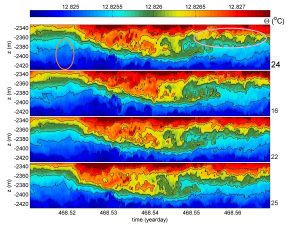17 October 2025 – We present a new paper with the title ‘Whipped and mixed warm clouds in the deep sea‘.
With a unique array of high-resolution temperature sensors we studied the turbulence in the deep sea, for the first time in 3D.
Turbulence redistributes nutrients for all life forms larger than microbial, on land and in the ocean.
Yet, the development of deep-sea turbulence has not been studied in three dimensions. For this purpose we installed an array of nearly 3000 high-resolution temperature sensors for three years on the flat 2500-m deep bottom of the Mediterranean Sea. We reported on the installation of the array in 2020. Here the recovery in 2024 is reported.
From the time series from this half-cubic hectometer 3D mooring-array we made unique movies of deep-sea water motions. In these movies we observed different levels of turbulence.
Although temperature differences are typically only 0.001 degrees Celsius, we observe variable convection-turbulence as expected from geothermal heating through the flat seafloor.
During about 40% of the time we observed the passage of clouds of additional turbulence, 3 times stronger in magnitude, from slantwise advected warmer waters from above or sideways.
Besides turbulent clouds and seafloor heating, the movies also reveal weakly turbulent interfacial-wave breakdowns that commonly occur in the open ocean far away from boundaries.
The paper has been submitted to Geophysical Research Letters. A pre-print is available at arXiv: 2510.09470
In the picture an example of a large breaker of warmer water including interfacial wave breakdowns recorded during less than 3 minutes in four neighbouring lines of the array with temperature sensors. Vertical axes depth of the sensors in meters; horizontal axis time of recording in days; colour coding indicates temperature of the water in degrees Celsius.
In the accelerated movie an example of recorded turbulence during one day in the full detector volume.


